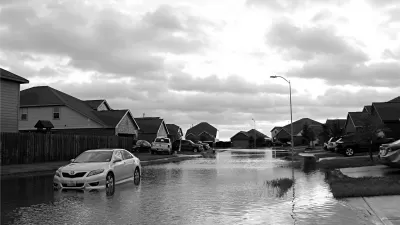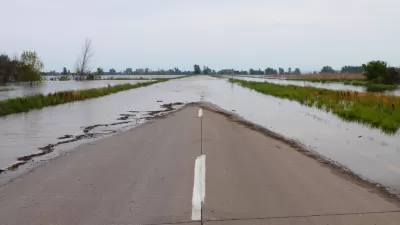More Americans are moving to high-risk flood zones as environmental deregulation wins the day.

Significant residential and commercial development is increasing the population in flood zones around the country, according to an analysis by Governing.
"Nationally, the number of Americans living in these high-risk areas in 2016 climbed 14 percent compared to those living in the same neighborhoods in 2000. That's actually faster than in areas outside of flood zones, where the population increased 13 percent … In fact, nearly all states recorded net population gains across their FEMA-designated floodplains in recent years."
The federal government has taken significant steps to allow more development in floodplains—like scrapping the Flood Risk Management Standard and scaling back the Waters of the United States Rule—but cities are guilty of trying to skirt restrictions as well, as writer Mike Maciag details. And for people already living in flood zones, it's easier to get disaster assistance than relocation assistance.
In a case study of South Carolina's Johns Island, Maciag concludes that better coordinated planning among jurisdictions could result in more holistic protection of watersheds and safer development. "The best solution would be a unified, interconnected drainage plan for the entire island rather than one that has developers accounting only for their individual properties," he suggests.
FULL STORY: RISKY WATERS

Planetizen Federal Action Tracker
A weekly monitor of how Trump’s orders and actions are impacting planners and planning in America.

Congressman Proposes Bill to Rename DC Metro “Trump Train”
The Make Autorail Great Again Act would withhold federal funding to the system until the Washington Metropolitan Area Transit Authority (WMATA), rebrands as the Washington Metropolitan Authority for Greater Access (WMAGA).

The Simple Legislative Tool Transforming Vacant Downtowns
In California, Michigan and Georgia, an easy win is bringing dollars — and delight — back to city centers.

The States Losing Rural Delivery Rooms at an Alarming Pace
In some states, as few as 9% of rural hospitals still deliver babies. As a result, rising pre-term births, no adequate pre-term care and "harrowing" close calls are a growing reality.

The Small South Asian Republic Going all in on EVs
Thanks to one simple policy change less than five years ago, 65% of new cars in this Himalayan country are now electric.

DC Backpedals on Bike Lane Protection, Swaps Barriers for Paint
Citing aesthetic concerns, the city is removing the concrete barriers and flexposts that once separated Arizona Avenue cyclists from motor vehicles.
Urban Design for Planners 1: Software Tools
This six-course series explores essential urban design concepts using open source software and equips planners with the tools they need to participate fully in the urban design process.
Planning for Universal Design
Learn the tools for implementing Universal Design in planning regulations.
Smith Gee Studio
City of Charlotte
City of Camden Redevelopment Agency
City of Astoria
Transportation Research & Education Center (TREC) at Portland State University
US High Speed Rail Association
City of Camden Redevelopment Agency
Municipality of Princeton (NJ)





























